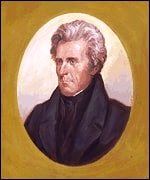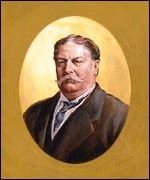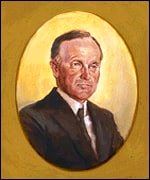The Charitable Irish Society and U.S. Presidents
By John P. Rattigan
Special to the Boston Irish Reporter - 2012
The Charitable Irish Society, founded in 1737, had a head start over the establishment of the United States of America by some 39 years. Since that time, the Society has been addressed by five U.S Presidents, three of whom were then holding office and two of whom had not yet attained that distinction.
Although non-political, the Society was a putative example of a large ethnic voting bloc in Massachusetts. Thus, it is not surprising that political leaders of every level and persuasion carefully cultivated a relationship with the Society in the hope of being favorably remembered in the succeeding election. Most often, this has been evident by an appearance at one of the Society’s annual dinners celebrating the feast of Saint Patrick as well as a day of remembrance of the Society’s founding.

Andrew Jackson
Andrew Jackson did not hesitate to describe himself as of Irish origin. His parents were Presbyterians from County Antrim, Northern Ireland and he was a member of the Hibernian Society of Philadelphia that he joined in 1819.
It was unusual for a sitting president to tour the states of the Union in the early 1800s, but Jackson, first elected to the office in 1828, did so during his second term. His travel included Boston, where he spoke at Harvard College and visited the USS Constitution.
During Jackson’s stay at the Tremont House in Boston, the Society’s President and a delegation of members called upon him on June 22, 1833. In reply to the greetings of the Society, Jackson responded by saying:
"It is with great pleasure that I see so many of the countrymen of my father assembled on this occasion. I have always been proud of my ancestry and of being descended from that noble race, and rejoice that I am so nearly allied to a country which has so much to recommend it to the good wishes of the world."

William Howard Taft
The 175th anniversary of the Society in 1912 was notable for not only the presence of President William Howard Taft, but likewise for the famous “dust up” between the Archbishop of Boston, William Cardinal O’Connell, and the then Massachusetts governor, Eugene Foss.
Remember, at this time, there was still palpable tension between the local Protestant and Catholic communities, especially in the matter of church and state relationships. Both sides were responsible for provocative statements and inflammatory behavior that just increased this friction.
For instance, at the 1908 centennial ceremonies marking the founding of the archdiocese, Archbishop O’Connell observed, or rather boasted, “The Pilgrim has passed. The Catholic remains.”
Only four months before the Dinner, Governor Foss publicly announced that he would not allow the state militia to march in a Boston parade honoring Archbishop O’Connell upon his return from Rome where he had been elevated to the College of Cardinals.
Being somewhat imperious by nature, the Cardinal was very comfortable with his new title and did not hesitate to exercise the perks that went along with the position. Just before the anniversary on March 17, 1912, word was passed to the Society’s Dinner Committee that protocol required the Cardinal to be seated next to the President on the dais and that he address the dinner guests immediately following Taft and before Governor Foss. This was grounded upon the theory that a “Prince of the Church” outranked a mere public servant, albeit governor, in the pecking order of protocol. The Committee made the change and when Foss learned of it, he was so infuriated that he boycotted the dinner. Consequently, there was no one to respond to the traditional toast “to the Commonwealth of Massachusetts”.
The Charitable Irish Society has always been proud of its diverse religious membership and ecumenical tradition. Twenty-six Irish Presbyterians founded the Society. By the time of the 175th anniversary in 1912, owing to the upward mobility of the sons and grandsons of famine era immigrants, Irish Catholics dominated the Society.
It is disturbing to look back at a time when fellow Christians stood so far apart from one another fully ignoring the spirit of tolerance. Such displays of petty bickering and the acrimony that characterized the 1912 dinner, as well as the whole milieu in Boston, would not really begin to wane until after the Second World War.

Calvin Coolidge
At the Annual Dinner in 1920, Governor Calvin Coolidge attended and answered to the toast “to the Commonwealth of Massachusetts”.
Coolidge was warmly received at the dinner according to newspaper accounts. It apparently did not matter that seven months previously Coolidge backed the firing of all of the participants in the Boston police strike, most of whom were Irish. This record was favorably counterbalanced by his vocal support for Irish independence. Coolidge’s decisive action in the police strike gained national attention and led to his election as Vice-President and his later succession to the Presidency upon the death of Warren G. Harding.

Franklin D. Roosevelt
On the 200th anniversary of the Society in 1937, President Franklin D. Roosevelt spoke simultaneously, via telephone, to both the Society and the Hibernian Society of Savannah, Georgia that was celebrating its 125th anniversary. At the time, Roosevelt was at his vacation retreat in Warm Springs, Georgia, where he would die eight years later.
In an unusually warm and personal greeting, Roosevelt said:
“It gives me great pleasure from this quiet spot in the Georgia hills to greet my friends of the Charitable Irish Society of Boston and the Hibernian Society of Savannah.
You in Boston, celebrating your two hundredth anniversary, are the oldest of the family. You in Savannah, celebrating your one hundred and twenty-fifth anniversary, are the youngest.
I have a particular tenderness for St. Patrick's Day for, as some of you know, it was on the seventeenth of March 1905, that a Roosevelt wedding took place in New York City with the accompaniment of bands playing their way up Fifth Avenue to the tune of "The Wearin' of the Green.” On that occasion New York had two great attractions—the St. Patrick's Day Parade, and President Theodore Roosevelt, who had come from Washington to give the bride away. I might add that it was wholly natural and logical that in the spotlight of these two simultaneous attractions, the bride and the bridegroom were almost entirely overlooked and left in the background.
Today, therefore, I am obtaining revenge for my obscurity on that occasion, for I am taking an actual personal part, even though it be by telephone, in one celebration of the day in the North and another celebration of the day in the South.
There is a further happy coincidence in this greeting which I am sending tonight to Boston and to Savannah. My children are the direct descendants of pioneer settlers of both your cities, Savannah through their mother, and Boston through their father. I am proud to participate in these celebrations and to have this fellowship with organizations which in former years were addressed by predecessors of mine in the Presidency of the United States…”
Once again, high drama and intrigue re-visited the stage of a Charitable Irish Society dinner. Just one month earlier, Roosevelt had unveiled his “court packing” plan to appoint additional justices to the U.S. Supreme Court. This was a blatant attempt to shift the balance away from the more conservative justices who, Roosevelt felt, had overturned and undermined much of his progressive New Deal legislation. This was an extremely controversial proposal that ultimately failed to gain much public support.
Roosevelt’s telephone remarks were to be followed by a speech by FDR’s personal representative, Harold Ickes, Secretary of the Interior. Shortly before the dinner, the Society’s President wrote to Ickes requesting that he not touch upon the “court packing” issue in his address. Ickes refused and threatened to withdraw if he was so restricted.
As it turned out, Ickes was unable to attend the dinner due to illness. Assistant U.S. Attorney General and Roosevelt intimate, Robert Jackson, replaced him. The President later appointed Jackson to the U.S. Supreme Court and during his tenure there, he served as Chief U.S. prosecutor at the Nuremberg war crime trials in Germany. FDR’s son, James Roosevelt, accompanied Jackson to the dinner.
Jackson, because he was a last minute replacement, did not have a prepared speech, but did his best to outline the positive aspects of FDR’s judicial reform plan. According to newspaper accounts, many of the dinner guests were hostile to these thoughts and answered with “subdued booing” during Jackson’s remarks.
Also on the speaking program was Martin Conboy, former U.S. Attorney for the Southern District of New York, and a fellow Democrat and ally of the Roosevelt administration. Yet, on this occasion, Conboy spent most of his speech castigating Roosevelt and tearing into the plan to reform the U.S. Supreme Court.
Harold Ickes later intimated that the Society officials had tried to “set him up” by adding Conboy to the program with the specific intention of embarrassing him. Circumstances spared Ickes from this fate, which fell upon the unsuspecting Robert Jackson.

John Fitzgerald Kennedy
After returning from naval service in World War II, John F. Kennedy, like most of his family, joined the Charitable Irish Society. His brother Joe had been a member along with his father, Joseph P. Kennedy. Both of his grandfathers, Patrick J. Kennedy and John “Honey Fitz” Fitzgerald, were prominent members as well.
Following his election to the U.S. Senate, Kennedy responded to the toast to the United States at the Society’s Dinner in March, 1953. Like many of the “cold warrior” politicians of this era, his remarks centered upon the free world and the encroaching threat of Communism.
There probably was no prouder moment for the Charitable Irish Society than the election to the Presidency of one of its own members in 1960. During his inaugural year as President, Kennedy instituted a formal recognition of Saint Patrick’s Day by hosting a reception at the White House. In making this nod to his Irish heritage, JFK spawned a tradition that continues to this day.
****
The Society’s chronicles with regard to these Presidential interactions open a window into times long past and the historical events that shaped the cultural and political thinking of the day. We learn some of the reasons which brought people together and the causes that sometimes drew them apart. From the Colonial days through the end of the 20th century, the Charitable Irish Society was a microcosm of life reflected in the larger world.
John P. Rattigan is a Past President and a current member of the Board of the Charitable Irish Society.